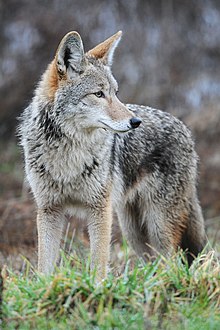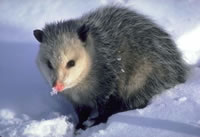Herbivores
The mule deer is the most commonly seen mammal in North America. Mule deer live in a variety of habitats including desert, woodlands, chapparrel, riparian, and conifer forests. In the desert they live in the higher elevations. I''ve seen many of these beautiful deer, even in my own neighhborhood.
Identification: Tan, grayish, or brown deer with a white rump and large mule-like ears. Length is 4-6 ft long. They're about 3 ft at the shoulder. They can weigh from 125-330 lb.
Diet: It will eat many things including vegetation, brush, herbs, and grasses.
Identification: Tan, grayish, or brown deer with a white rump and large mule-like ears. Length is 4-6 ft long. They're about 3 ft at the shoulder. They can weigh from 125-330 lb.
Diet: It will eat many things including vegetation, brush, herbs, and grasses.
Bighorn Sheep:
The Bighorn Sheep is one of the few mammals to survive the high crags and canyons of California's mountains. They are very reclusive and I have never seen them. Small groups of male bighorns are led by a dominant ram, while the larger female group's leader is an old ewe. Bighorns are brown sheep with white patches, and are easily identified by their large curving horns. The male's horns are larger and more spiraled. In addition to high mountainous cliffs, Bighorns inhabit desert mountains where they drink from desert oases, and they are also good swimmers.
Identification: Large brown sheep with white patches that are easily identified by their large curving horns. The male's horns are larger and more spiraled. Length is around 4 1/2 to 5 1/2 ft. Height at the shoulder is about 3 ft. Weight is 115-280 lb.
Brush Rabbit
This common rabbit is very successful and lives almost everywhere on the West Coast. Some of its habitat includes deserts, mountains, and fields.The upperside of the Brush Rabbit's fur varies from light brown to gray in color, while the underside is usually always white. Adult rabbits measure anywhere from 10-14 inches long and rarely weigh over two pounds. The Brush Rabbit feeds mainly on grasses and forbs, especially green clover, though it will also eat berries and browse from bushes.
Western Gray Squirrel
This critter lives all over America. They can be found in forests and nest in the tops of trees. Adult size varies from 11 to 15 inches and weigh about 1 pound. They feed on acorns and pinecones. Some get stored in their house for their Winter hibernation. Their overside is light gray and their underside is pure white. Over the past 20 years their numbers have been falling in California. Still they aren't endangered and they seem to be coming back.
California Ground Squirrel
California ground squirrels are very common mammals and are found throughout almost all of California and through western Oregon. Unlike most ground squirrels, it is quite large, as it can grow to nearly 20 inches long. The coloring is brownish-white with a light patch at the neck like a collar. It prefers open fields, rocky areas, and woodlands and forests, where they burrow into the ground like all ground squirrels. They are preyed upon by many animals such as eagles, coyotes, rattlesnakes, and badgers, but have adapted various ways to evade their predators, especially rattlesnakes.
Omnivores
House Mouse
This small very common mouse is actually native to Asia, but it became associated with people hundreds of years ago and is now common throughout the whole world. House mice live outdoors when the weather is warm enough, but when winter arrives they move into people's houses, hence the name. They need to reproduce very quickly because they have very short lives.
Identification: They usually grow to about 6 inches long with a gray body and a long naked tail.
Diet: They eat practically anything: corn, berries, nuts, or human food
Merriam Chipmunk
Merriam Chipmunks are small chipmunks that live in the mountainous, <9,000 areas of Southern and Central Calfornia. They live up to 5 years in the wild. Merriam chipmunks don't hibernate and live in gopher holes or in trees. They have a series of calls and chirps and are prey to many other creatures such as hawks, badgers, weasels, bobcats, rattlesnakes, garter snakes, owls and more.
Identification: Small grayish-brown chipmunk, 5 in long, about 2.5 oz, not too bushy tail.
Diet: Both plant and animals food, up tp 70 plant types, acorns, seeds, insects, and lizards.
Long-Tailed Weasel

Long-Teiled
Common Raccoon
 |
| Raccoon picture from here |
The very intelligent and highly adaptable Raccoon lives in a wide variety of habitats. Woodlands, wetlands, rural urban, dedicious forests, and suburban areas can all create a happy home for a Raccoon. They mate in the late winter or spring and 1 to 8 young are born. The offspring leave their mother in late summer to fall.
Identification: Raccoons are grayish-brown with the unique "masked" face and a striped tail. They measure 16-28 cm, not including the tail which can measure between 8 and 16 cm and it can weigh 4-30 pounds.
Diet: It eats almost everything, from garbage to fish to insects.
Identification: Raccoons are grayish-brown with the unique "masked" face and a striped tail. They measure 16-28 cm, not including the tail which can measure between 8 and 16 cm and it can weigh 4-30 pounds.
Diet: It eats almost everything, from garbage to fish to insects.
Striped Skunk
 |
| click here for website |
Spotted Skunk
Spotted skunks are very much like the striped skunks in size, and diet. However, the spotted skunk prefers desert, chaparrel, and woodlands over thick forests. I once saw a dead one while hiking in Chino Hills State Park (pictured above).They commonly feed on rodents, fruit, berries, birds, eggs, insects and larvae, carrion, lizards and even snakes. In the wild half of the skunks die after one or two years but skunks can live up to six years in captivity. (Skunks are only allowed to be pets in less than 20 states though)
Virginia Opossum
| Picture from HERE |
The Opossum is the only marsupial in North America. Virginia opussums are not native to California. However I wll include them because they are now what is called "naturalized", which simply means the species has adapted very well to the area in which it was introduced. It eats berries, insects, lizards, birds, and eggs. In addition to this natural diet many 'possums have moves in to urban areas where they raid dumps and trash cans. They are about the size of a cat. It lives in woodlands, farmlands, forests, and urban areas. Opussums have a short lifespan; they die in about two years.
Black Bear
The Black bear is very widespread throughout much of America. It is very good at climbing and swimming. This large omnivorous bear has a diet that consists mainly of vegetable origin, such as berries, nuts, roots, leaves, and honey. However, the Black Bear does occasionally eat fish and small mammals. Sadly, it has become a threat to people since it has discovered dumps. Although the word "black" is in its name, it isn't always black. In California, many are brownish or even blond.
American Badger
Though AMERICAN BADGERS are small in comparison to many animals, they are fierce and rarely are killed by could-be predators such as bears and mountain lions. Their real threats are farmers, cars, and hunting for their beautiful fur. In short, humans. In the wild, they usually live about 9 to 10 years. They primarily prey on squirrels, rats, and other small rodents. An interesting partnership is formed by the badger and the coyote to help each other hunt food. The badger is not a fast runner but can dig very well. Coyotes are fast but bad diggers. So sometimes this unlikely duo will come together to help each other survive.
Carnivores
Mountain lion
 |
| picture from here |
MOUNTAIN LIONS, also known as cougars, pumas, mountain cats, catamounts, or panthers are one of the most successful predators in North America. It has the greatest range of all big cats from the Yukon to the jungles of South America. It is a solitary cat that can weigh over 150 pounds. It will usually feed on deer, elk, moose, and bighorn sheep, but that's not all. The secret to their success is that they eat anything: rodents, opossum, even duck. They can also go for domestic livestock. Attacks on humans are rare. In fact if you see a mountain lion you're very lucky. Mountain lions are very smart and know not to mess with humans and once they have a scent of one they run.
Coyote


COYOTES are commonly seen omnivores throughout North America. They have expanded their range past their original grassland and desert habitat when wolves became scarce and now occur from Alaska to Panama. They are oppurtunistic predators, and their diet ranges from both small and large mammals to reptiles to birds to fruits and vegetables in the fall and winter. They sometimes hunt in packs and are able to bring down large prey such as an elk or a deer. They have a wolflike appearance and can be around 40 to 50 inches long and have a reddish or gray body, a light tan belly and legs, and a darker gray foxlike tail.
Island Gray Fox
 |
| Picture fron here |
ISLAND GRAY FOXES are only native to six of the eight Channel Islands. Each island has at most 1,000 foxes. They are rated Critically Threatened due to human activities and predation by the golden eagle, which can be up to four times larger then the island gray fox, the smallest fox in North America. It only weighs about four pounds and its coloring is gray on the top of its head and on the back, red on its sides, and a white belly and throat.
| captive at santa barbara zoo |
Bobcat
 |
| both pictures from here |
 BOBCATS are the most common large cats in the US, with total numbers throughout the country around one million. But despite their commonness and availability to live in almost any environment (such as forest, desert, swamp, grasslands, etc) they are rarely seen because they are very elusive, and only active at night. Their range extends throught all of America except in aome of the Plains and Great Lakes area, north into Canada, and as south as central Mexico. They are small, aout twice the size of a large housecat, with long legs, large paws, tufted ears, and a "bobbed" tail, hence the name. The ground color is a brownish-yellow with darker blotches. They are oppurtunistic hunters and can take down larger animals but usually prey on rabbits, birds, mice, squirrels and other small animals.
BOBCATS are the most common large cats in the US, with total numbers throughout the country around one million. But despite their commonness and availability to live in almost any environment (such as forest, desert, swamp, grasslands, etc) they are rarely seen because they are very elusive, and only active at night. Their range extends throught all of America except in aome of the Plains and Great Lakes area, north into Canada, and as south as central Mexico. They are small, aout twice the size of a large housecat, with long legs, large paws, tufted ears, and a "bobbed" tail, hence the name. The ground color is a brownish-yellow with darker blotches. They are oppurtunistic hunters and can take down larger animals but usually prey on rabbits, birds, mice, squirrels and other small animals. Have fun and enjoy God's animals :)











